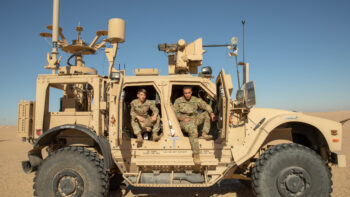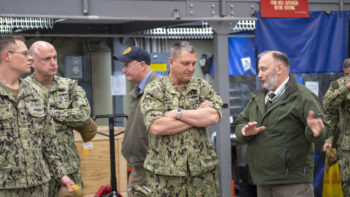
Photo by Timothy Hale
The Defense Enclave Services (DES) program will provide IT services to U.S. Department of Defense agencies and departments not directly part of the individual military services or intelligence agencies. Categorized as the Fourth Estate, these 22 organizations range from the Office of the Secretary of Defense to the Defense Health Agency, Defense Logistics Agency and Missile Defense Agency. DES will consolidate and standardize networks, processes, tools, and infrastructure in order to streamline email, voice and video, printing, file sharing, and help desk, as well as cybersecurity functions like identity management.
In this Q&A with Navy Vice Admiral (Ret.) Ted Branch, former deputy chief of naval operations for information warfare and presently Perspecta’s senior vice president and general manager of the Navy and Marine Corps business, we discuss innovations and challenges expected with the DES program that the Defense Information Systems Agency (DISA) is charged with implementing.

Ted Branch, Senior Vice President and General Manager, Navy and Marine Corps Group at Perspecta
Breaking Defense: How do you deliver innovation when a driver of DES is to simplify operations with standard applications and tools?
Branch: There is a clear need for what DES plans to accomplish: common-use IT on a consolidated network with a single provider that leads to lower cost and less risk. Finding the balance between standardization and innovation is key. Given the current state of the environment, providing all the intended functionality with one provider is in itself innovative. Getting there will take new thinking and specific technologies along with standardized applications and tools. The end result will be a digital workplace with a consumer-like experience in a secure environment. Taking this a step further, DES will remove the burden of help desk support and other time-draining activities for all these agencies. Each Fourth Estate agency has a unique mission that requires innovation, and with DES they can devote more of their resources to that.
Breaking Defense: What are the challenges associated with the DES modernization?
Branch: From Perspecta’s transformation experience, it’s important to first understand the end users and their as-is environment. Existing capabilities must continue to support the mission while you proceed with the modernization effort.
Perspecta created a methodology for this from the thousands of network migrations we performed as part of our management of the Navy and Marine Corps Intranet (NMCI). Most recently, we applied this when we set up 5,000 new seats with associated printers for the Navy Supervisor of Shipbuilding under the Naval Sea Systems Command. We had to understand the details of their existing operations and enable the command to continue ship maintenance and construction.
A second challenge to overcome is that there will be inevitable changes in priorities. Plans must have flexibility to accommodate these shifts in order to avoid cost increases or delayed adoption. For us, that plan is a transformation roadmap that includes input from the stakeholders and ensures they are prepared for that transformation journey. It provides actionable waypoints to measure progress and offers a shared perspective of the cross-functional impacts that will occur. This creates common ground and serves as a good catalyst for communication among all the parties.
A third challenge to expect is that adoption will not be uniform. Established procedures and a committed governance team will guide the program, much like DISA has a collaboration council for the Defense Information System Network (DISN). They meet every month to make sure all the stakeholders have a voice in what’s going on. Furthermore, engaging users in change management will get them invested into the program and put them in a better position to succeed with it.
Breaking Defense: What are the elements you would expect to see in DES?
Branch: It would include putting everything in a secure cloud unless there’s a good reason not to. That’s the most efficient way to reduce the number of networks and duplicative environments, as well as optimize the IT management tools and enhance cybersecurity.
Perspecta did this recently for the Army’s Total Ammunition Management System (TAMIS). We moved to the AWS GovCloud all of TAMIS’s tactical and training ammunition requests and expenditures for the Army, Marine Corps, National Guard, and reserves. Built on an agile DevOps framework for the AWS GovCloud environment, TAMIS generated multiple metrics: 80 percent quicker production time, 63 percent improvement in operational efficiency, and 50 percent reduction in IT spend. Perhaps most importantly, TAMIS fulfilled all requirements throughout the time that Perspecta performed the migration.
I also anticipate that DES would have the latest in user productivity tools like Microsoft 365, SharePoint, and OneDrive cloud services that are much easier to maintain. One of our federal agency customers had a similar scenario when it made the decision to modernize with cloud technologies. We transitioned 27,000 mailboxes and 6,000 mobile devices to Microsoft 365 using the Microsoft Government Community Cloud. That agency could then use the Microsoft messaging and collaboration cloud product set, which makes them inherently more efficient than the legacy IT model that required large physical data centers.
Another key component of a DES transformation will be a managed service capability. It is the most efficient way to deliver the suite of services to 22 disparate agencies. This should have automated functions for asset and lifecycle management and full visibility into multi-cloud infrastructure and operations. Through its Zeus tool hosted on a FedRAMP cloud infrastructure, Perspecta provides this capability to the federal government today at core data centers and customer sites.
And finally, it is essential for DES to use software-defined networking for maximum flexibility. This approach to network management enables dynamic, efficient network configuration to improve performance and monitoring, and makes changes almost in real time. For one state and local government customer, we recently implemented software-defined networking using Information Technology Infrastructure Library (ITIL)-based service management. This allows us to scale their network quickly and reduces the amount of time needed to activate network connectivity from months to just days.





















